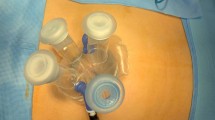Abstract
Objective
The management of the hernia sac is the core step of laparoscopic indirect inguinal hernioplasty. In this study, a randomized controlled trial was conducted to evaluate the clinical effect of laparoscopic total extraperitoneal inguinal herniorrhaphy (TEP) with hernia sac transection and complete sac reduction.
Method
From May 2017 to May 2018, 70 patients aged 18–75 with primary indirect inguinal hernia in our hospital were randomly divided into a transected sac group (TS) and a completely reduced sac group (RS). The primary outcomes compared between the two groups were the hernia sac treatment time, operation time, and the incidence of seroma formation after operation. Secondary outcomes included acute pain, chronic pain (pain which lasted for at least 3 months), hospital stay, recurrence rate, and other complications.
Result
There were no significant differences in baseline demographic characteristics including age, sex, hernia type, size of hernia defect, and follow-up time between the two groups. The times required for hernia sac separation and operation in the TS group were significantly shorter than in the control group (6.1 ± 2.3 vs. 25 ± 5.8 min for hernia sac separation, p < 0.01; and 35.10 ± 3.50 vs. 54.40 ± 4.20 min for operation, p < 0.01). There was no significant difference in hospitalization time, incidence of acute pain, seroma formation, or urinary retention between the two groups. During the 12-month follow-up period, chronic pain, early recurrence, and other complications were not found in either group.
Conclusion
Both the hernia sac transection technique and the complete sac reduction technique are safe and reliable. The hernia sac transection technique is a simple and effective hernia sac treatment method. It reduces the operation time and does not increase seroma or acute or chronic pain. It is valuable and likely to be popularly applied.



Similar content being viewed by others
References
Eklund A, Carlsson P, Rosenblad A et al (2010) Long term costminimization analysis comparing laparoseopic with open (Lichtenstein) inguinal hernia repair. Br J Surg 97(5):765–771
Ielpo B, Nuñez-Alfonsel J, Duran H, Diaz E, Fabra I, Caruso R, Malavé L et al (2018) Cost-effectiveness of randomized study of laparoscopic versus open bilateral inguinal hernia repair. Ann Surg 268(5):725–730. https://doi.org/10.1097/SLA.0000000000002894
Mazaki T, Mado K, Masuda H et al (2013) Antibiotic prophylaxis for the prevention of surgical site infection after tension-free hernia repair: a Bayesian and frequentist meta-analysis. J Am Coil Surg 217(5):788–801
Mahon D, Decadt B, Rhodes M (2003) Prospectiver andomized trail of laparoscopic (transabdominal preperitoneal) vs open (mesh) repair forbilateral and recurrenting uinal heria. Surg Endosc 17(9):1386–1390
Bay-Nielsen M, Kehlet H, Strand L et al (2001) Quality assessment of 26,304 herniorrhaphies in Denmark: a prospective nationwide study. Lancet 358(9288):1124–1128
Aravind B, Cook A (2015) Intra-abdominal giant infected seroma following laparoscopic inguinal hernia repair. Hernia 19(5):795–797
Gutlic N, Gutlic A, Petersson U, Rogmark P, Montgomery A (2019) Randomized clinical trial comparing total extraperitoneal with Lichtenstein inguinal hernia repair (TEPLICH trial). Br J Surg 106(7):845–855. https://doi.org/10.1002/bjs.11230
Zhu X, Cao H, Ma Y et al (2014) Totally extraperitoneal laparoscopic hernioplasty versus open extraperitoneal approach for inguinal hernia repair: a meta-analysis of outcomes of our current knowledge. Surgeon 12(2):94–105
Shah NS, Fullwood C, Siriwardena AK et al (2014) Mesh fixation at laparoscopic inguinal hernia repair: a meta-analysis comparing tissue glue and tack fixation. World J Surg 38(10):2558–2570
Choi YY, Kim Z, Hur KY (2011) Transection of the hernia sac during laparoscopic totally extraperitoneal inguinal hernioplasty: is it safe and feasible? J Laparoendosc Adv Surg Tech A 21(2):149–152
Chen LS, Chen WC, Kang YN, Wu CC, Tsai LW, Liu MZ (2019) Effects of transabdominal preperitoneal and totally extraperitoneal inguinal hernia repair: an update systematic review and meta-analysis of randomized controlled trials. Surg Endosc 33(2):418–428. https://doi.org/10.1007/s00464-018-6314-x
Agrawal M, Bhagwat S, Rao P (2018) Dulucq’s technique for laparoscopic totally extraperitoneal hernioplasty. J Minim Access Surg. https://doi.org/10.4103/jmas
Asuri Krishna MC, Misra VK, Bansal S, Kumar S, Rajeshwari Chabra A (2012) Laparoscopic inguinal hernia repair: transabdominal preperitoneal (TAPP) versus totally extraperitoneal (TEP) approach: a prospective randomized controlled trial. Surg Endosc 26:639–649
Ruze Rexiati, Yan Zhibo, Qunzheng Wu, Zhan Hanxiang, Zhang Guangyong (2019) Correlation between laparoscopic transection of an indirect inguinal hernial sac and postoperative seroma formation: a prospective randomized controlled study. Surg Endosc 33:1147–1154
Lau H, Lee F (2003) Seroma following endoscopic extraperitoneal inguinal hernioplasty. Surg Endosc 17:1773–1777
Cihan A, Ozdemir H, Uçan BH et al (2006) Fade or fate. Seroma in laparoscopic inguinal hernia repair. Surg Endosc 20:325–328
Köckerling F, Bittner R, Adolf D et al (2018) Seroma following transabdominal preperitoneal patch plasty (TAPP): incidence, risk factors, and preventive measures. Surg Endosc 32:2222–2231
Acknowledgements
The authors are thankful to the Second Affiliated Hospital of Kunming Medical University for the management of our inguinal hernia patient database. This work was supported by the Wu Jieping Medical Foundation of China (No. 320.6750.16211) and Yunnan health training project of high level talents (No. D2017037).
Author information
Authors and Affiliations
Corresponding authors
Ethics declarations
Disclosures
Drs. Weiming Li, Yijun Li, Lili Ding, Qingwen Xu, Xiongzhi Chen, Shumin Li, Yueying Lin, Pengyuan Xu, Dali Sun, and Yanbo Sun have no conflicts of interest or financial ties to disclose.
Additional information
Publisher's Note
Springer Nature remains neutral with regard to jurisdictional claims in published maps and institutional affiliations.
Electronic supplementary material
Below is the link to the electronic supplementary material.
Supplementary material 1 (MP4 304460 kb)
Rights and permissions
About this article
Cite this article
Li, W., Li, Y., Ding, L. et al. A randomized study on laparoscopic total extraperitoneal inguinal hernia repair with hernia sac transection vs complete sac reduction. Surg Endosc 34, 1882–1886 (2020). https://doi.org/10.1007/s00464-019-07303-x
Received:
Accepted:
Published:
Issue Date:
DOI: https://doi.org/10.1007/s00464-019-07303-x




